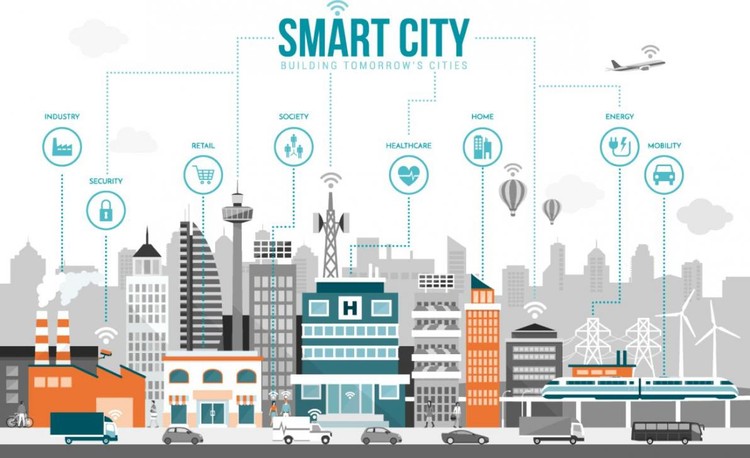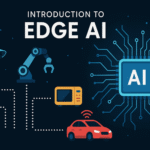Smart Cities step in, using technology to create safer, cleaner, and more efficient living spaces. Cities are the heart of human civilization. By 2050, more than 68% of the world’s population is expected to live in urban areas. But with rapid urbanization comes challenges-traffic congestion, pollution, waste management, and public safety.

What is a Smart City?
A Smart City is an urban area that uses digital technology, data, and connected infrastructure to improve quality of life, optimize resources, and ensure sustainable growth.
Think of it as a city that “thinks and responds” to the needs of its citizens.
Key Features of Smart Cities
- Smart Infrastructure
- Sensors in roads, buildings, and utilities.
- Automated traffic lights that reduce congestion.
- Sustainable Energy
- Solar-powered streetlights.
- Smart grids that balance electricity usage.
- Smart Transportation
- Real-time bus/train tracking.
- Electric vehicle charging stations.
- Shared mobility (e-scooters, ride-hailing apps).
- Waste Management
- Smart bins that notify authorities when full.
- AI-powered recycling systems.
- Public Safety
- CCTV with AI for crime detection.
- Emergency alert systems.
- E-Governance
- Online citizen services (taxes, licenses, complaints).
- Open data platforms for transparency.
Examples of Smart Cities Worldwide
- Singapore: Known as the world’s smartest city with AI traffic management, automated waste systems, and smart healthcare.
- Dubai: Uses blockchain for government services, AI for traffic, and smart police stations.
- Barcelona: Has smart lighting, Wi-Fi hotspots across the city, and IoT-enabled water systems.
- Amsterdam: Focused on sustainable living with smart grids and eco-friendly housing.
The Dubai smart city initiative is a comprehensive government-driven plan that aims to integrate advanced digital solutions into everyday life. This initiative not only creates a better quality of urban living but also improves efficiency in public services, transportation, and energy management.
Examples of Focus Areas
- Smart Mobility: Using technology to manage traffic, improve public transit, and promote eco-friendly transportation options.
- Smart Governance: Automating city functions, improving transparency, and providing better digital government services.
- Smart Environment: Utilizing smart grids for efficient energy use, optimizing water management, and improving waste collection.
- Smart Health: Enhancing healthcare services through technology and data-driven insights.
Benefits
- Reduced traffic jams and faster commutes.
- Lower energy costs and carbon footprint.
- Improved healthcare and safety.
- More transparency in governance.
- Better quality of life for citizens.
Challenges of Smart Cities
While the idea is futuristic, it face hurdles:
- High costs of infrastructure.
- Data privacy concerns from 24/7 surveillance.
- Cybersecurity risks as systems go online.
- Digital divide – not all citizens have access to technology.
The difficulties of integrating new technologies into existing infrastructures results in most data gathered being incomplete and incorrect, thus failing the smart city vision to enhance urban governance.
Disadvantages of Smart Cities are Concerns, Privacy and Data Security, Digital Divide, Infrastructure Reliability, Financial Burden Implementing and maintaining, Ethical and Social Issues, Environmental. Municipal Governments: Local governments are often the primary drivers of smart city initiatives. They are responsible for urban planning, infrastructure development, and public services.
Future of Smart Cities
With the rise of 5G, AI, IoT (Internet of Things), and renewable energy, the future of smart cities looks promising.
Imagine cities where:
- Driverless cars reduce accidents.
- AI doctors provide instant diagnosis.
- Smart homes adjust lighting, temperature, and security automatically.
By 2030, many major cities will likely adopt smart city technologies to tackle urban challenges while creating eco-friendly, sustainable spaces.
Conclusion
Smart cities represent the next step in urban evolutio-where technology is not just an add-on but the backbone of city life. While challenges exist, the vision of sustainable, efficient, and citizen-friendly cities is becoming a reality faster than ever.
If implemented right, smart cities won’t just be about gadgets and data-they’ll be about building better lives. Also Check How to Build Your First Mobile App – Free Guide – 2025




1 thought on “Smart Cities – The era of Tech – Free Guide – 2025”